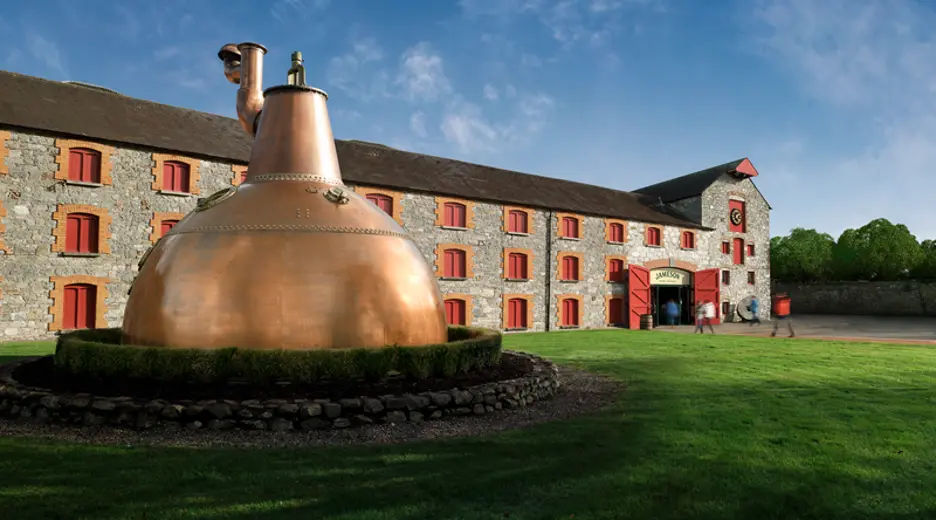
What is a Single Pot Still Whiskey?
What is Single Pot Still Whiskey?
Single pot still whiskey is a unique gem in the Irish whiskey collection, made by a single distillery from a charming blend of malted and unmalted barley. This special mix then goes through the pot still distillation, a pivotal step in creating Jameson Irish Whiskey. This traditional method adds significantly to the whiskey’s distinctive flavour profile and smoothness, ensuring it stands out in the whiskey world
To truly appreciate this process and its importance to Jameson, delving into how Jameson is made reveals the artistry and heritage behind this iconic whiskey.
Single Pot Still Distillation Process
Irish pot still whiskey undergoes triple distillation in grand copper pot stills. These pot stills come in various shapes—onion, conical, ball, or lantern—but they’re always made of trusty copper. The still’s head, connected to the pot, also varies in shape—tapered, straight-sided, short, or long. The lyne arm, linking to the head via the swan neck, directs vapour to the shell and tube condenser, where it’s transformed back into liquid form.
The First Distillation
The wash is pumped into the first of three large copper pot stills and heated. As the pot still warms, the alcohol boils, sending vapours up the neck of the still, along the lyne arm, and into a condenser. Here, the vapours cool and turn into a liquid called ‘low wines’. Since the temperature never hits 100°C, most of the water stays behind, unable to vaporise. After this first distillation, the low wines are 25-40% ABV.
The Second Distillation
Next, the low wines are moved to the second pot, where the magic happens again. As the alcohol vapours rise and condense, they’re collected in two separate vessels. The initial vapours, rich in volatile alcohol esters, add fruity notes to the spirit but can be too intense for the final whiskey. These are the ‘heads cut’, cooled and set aside by the distiller. The middle vapours, with a perfect balance of alcohols and flavours, are destined to mature into a rich and complex whiskey. This ‘centre cut’ or ‘hearts’ is collected separately. The last vapours, known as the ‘tails cut’, are heavier and join the heads cut in the same receiver. The heads and tails are then sent back to the pot for the next batch of low wines.
The Third Distillation
The centre cut from the second distillation, now called ‘strong feints’, heads to the spirit still for the final distillation. Vapours condense again, with heads and tails collected in one receiver and the centre cut in another. This centre cut, known as the new make spirit, is ready for wooden c casks and years of maturation, sitting at about 84% ABV. Some demineralized water is added to maximise the effects of maturation. The demineralized water brings the ABV down to about 64%. This new make pot still spirit boasts robust, spicy, and aromatic flavours. After the third distillation, heads and tails are typically sent back to the pot for the next batch of strong feints.
History of Pot Still Whiskey
Single-pot still whiskey finds itself at a crucial juncture in whiskey’s history. It sprang to life as a crafty response to the 1785 tax in Ireland, which slapped duties on malted barley—a key whiskey ingredient—and the spirit it produced.
To dodge this tax, resourceful Irish distillers mixed in unmalted barley into their mash bill. This clever move not only trimmed down the taxable malted barley but also birthed a whiskey with a distinctive creamy mouthfeel. And so, Single Pot Still Irish Whiskey was born, carving out a new and lasting niche in the whiskey world.
What’s the Difference Between Pot Still Vs. Column Still
The distinction between pot stills and column stills is crucial in whiskey production, affecting both flavour and efficiency. Pot stills, the artisans of the whiskey world, their batch process involves heating the wash (fermented liquid) in the pot, where vapours gracefully rise through the neck, condense, and are collected.
This method retains more congeners, resulting in richer, more complex flavours and often requires multiple distillations to enhance purity, adding layers to its character. Pot stills are ideal for single-malt Irish whiskey, highlighting traditional craftsmanship and intricate flavours.
On the other hand, column stills, also known as continuous or Coffey stills, are the skyscrapers of distillation—tall, stainless steel towers equipped with plates or trays. The continuous process involves introducing the fermented wash into the midsection of the column, while steam rises from the bottom. This interaction allows for seamless distillation, efficiently separating components.
Column stills achieve higher purity and alcohol content in a single run, making them ideal for large-scale production. Despite their reputation for producing lighter spirits, column stills can be fine-tuned to adjust congener concentrations, offering a range of whiskey profiles from delicate to robust. They are commonly used in bourbon production, balancing efficiency with flavour precision.

Is Jameson Made in a Pot Still?
Jameson sets itself apart with a blending process that’s more of an art form, mixing rich pot still whiskey, made from both the rebellious unmalted and the compliant malted barley, with the finest grain whiskey. Each component undergoes a triple distillation marathon, a meticulous routine that ensures the smoothness of the final pour.
This careful distillation and blending technique is the secret behind Jameson’s famed smoothness and robust flavour profile, making it a standout character in the whiskey world.

Pot Still vs Single Malt?
Single Malt Irish Whiskey is a purist’s delight, crafted entirely from 100% malted barley at a single distillery in Ireland. In contrast, Single Pot Still Whiskey is a bit more rebellious, made from a cheeky mix of malted and unmalted barley, and triple distilled in a pot still, but still loyal to its single distillery roots in Ireland.
The key distinction here is that while single malt whiskey is a globetrotter, Single Pot Still Whiskey proudly boasts a unique geographical indication, being exclusively and quintessentially Irish.
What Does Single Pot Still Whiskey Taste Like?
Malted and unmalted barley is triple distilled, resulting in a rich, unmistakable silkiness coupled with a distinctive pot-still spiciness.
Jameson Single Pot Still perfectly embodies the traditional Irish Whiskey-making style after which it is named, offering a classic example of this method’s unique characteristics.
